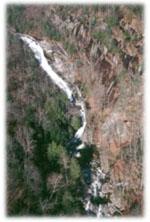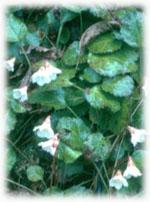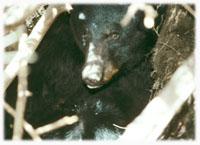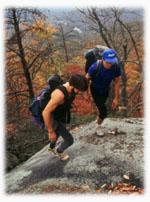 |
In the uppermost reaches of South Carolina, the clear
waters of Lake Jocassee splash against the base of the Blue Ridge Escarpment, a
"Blue Wall" of hills that represent the sharp transition between our
Carolina Mountains and Piedmont. Here forested slopes drop in elevation by 2,000
vertical feet in a matter of one to two miles.
 This steep
forested condition represents the Escarpment's general character throughout its
length in Virginia, the Carolinas and Georgia. Around Lake Jocassee (from the
South Carolina/Georgia line eastward to Jones Gap State Park), however, a series
of steep-sided gorges carrying surging mountain rivers and streams down to the
Piedmont has cut the generally uniform sloping face of the Escarpment. These
gorges together are known as the Jocassee Gorges. This steep
forested condition represents the Escarpment's general character throughout its
length in Virginia, the Carolinas and Georgia. Around Lake Jocassee (from the
South Carolina/Georgia line eastward to Jones Gap State Park), however, a series
of steep-sided gorges carrying surging mountain rivers and streams down to the
Piedmont has cut the generally uniform sloping face of the Escarpment. These
gorges together are known as the Jocassee Gorges.
 Streams
with names such as Saluda, Eastatoe, Laurel Fork, Toxaway, Horsepasture,
Bearcamp, Thompson, Whitewater, Devils Fork and Chattooga carved these rugged
gorges and produced scenic waterfalls and other natural beauties. These gorges,
their streams, and the more than 75 inches of precipitation that occurs here
each year make this area unique among mountain settings in the eastern United
States. Streams
with names such as Saluda, Eastatoe, Laurel Fork, Toxaway, Horsepasture,
Bearcamp, Thompson, Whitewater, Devils Fork and Chattooga carved these rugged
gorges and produced scenic waterfalls and other natural beauties. These gorges,
their streams, and the more than 75 inches of precipitation that occurs here
each year make this area unique among mountain settings in the eastern United
States.
The name "Jocassee," according to Native American legend, means
"Place of the Lost One." Evocative Indian names echo throughout the
Jocassee region, such as Oconee and Eastatoe, both tribes which inhabited the
area. The Eastatoees were called the Green Birds and likely received their name
from the Carolina parakeet, the only parrot native to eastern North America, a
species that became extinct in 1904. The Eastatoe valley was the last site where
scientists recorded a sighting of the species in South Carolina. 
This region has drawn the attention of scientists for centuries. It is where, in
the mid-1700s, William Bartram discovered the flame azalea along with other
species new to science, and enjoyed "a view inexpressibly magnificent and
comprehensive" from the crest of Oconee Mountain (now Station Mountain).
In 1787, botanist Andre Michaux discovered his "small plant with
saw-toothed leaves" that today is recognized as Oconee bells, a rare plant
species that is a hallmark of the Jocassee Gorges. It was also the location of
many detailed botanical studies that in the mid-1900s documented the unique
qualities of the Jocassee Gorges region.
 During the
past century, much of the land has been owned and managed by commercial timber
interests. In more recent years, the area has also been the site of important
wildlife and fisheries restoration projects involving white-tailed deer, wild
turkey, peregrine falcons, and brook trout, among others. Perhaps most
important, this mountainous region across the upper reaches of South Carolina
and adjacent North Carolina and Georgia has been the site of major conservation
and land preservation efforts over the past decades. These efforts involved
federal and state agencies, land trusts, conservation groups and corporations.
These organizations have provided for us, and future generations, a protected
landscape and ecosystem that will ensure the continuation of important natural
resources while allowing compatible and safe use by the public. During the
past century, much of the land has been owned and managed by commercial timber
interests. In more recent years, the area has also been the site of important
wildlife and fisheries restoration projects involving white-tailed deer, wild
turkey, peregrine falcons, and brook trout, among others. Perhaps most
important, this mountainous region across the upper reaches of South Carolina
and adjacent North Carolina and Georgia has been the site of major conservation
and land preservation efforts over the past decades. These efforts involved
federal and state agencies, land trusts, conservation groups and corporations.
These organizations have provided for us, and future generations, a protected
landscape and ecosystem that will ensure the continuation of important natural
resources while allowing compatible and safe use by the public.
Jocassee Gorges was protected thanks to a cooperative acquisition effort between
the S.C. Department of
Natural Resources (DNR), Duke
Energy and the Richard
King Mellon Foundation, assisted by The
Conservation Fund. Recently completed and proposed acquisitions of these
Jocassee Gorges lands by state and federal agencies -- and the establishment by
Duke Energy of a conservation easement on portions of its retained holdings --
ensure the continued protection of significant natural and recreational
resources. It also provides an important physical linkage with extensive
Mountain Bridge Wilderness Area lands to the east and National Forest lands to
the west.
Together, these areas, plus conservation lands in adjacent North Carolina and
Georgia, provide protection for about 150,000 acres associated with South
Carolina's Blue Ridge Escarpment and its watersheds.
 The
Jocassee Gorges tract contains about 43,500 acres. The S.C. Department of
Natural Resources owns most of this land, and activities here are governed by a management
plan and regulations they've developed, in large part, in response to public
input. The U.S. Forest
Service proposes to purchase land on the western edges of the tract and will
manage these holdings as part of Sumter National Forest. Duke Energy, the former
owner of all the Jocassee Gorges tract, has maintained ownership of some of the
lands for the operation of its Bad Creek Pumped Storage Station. Duke Energy is
also retaining other lands as an option for additional pumped storage hydro
generation but has otherwise given up development rights through a conservation
easement to the DNR. Public access to the Duke Energy lands is allowed.
Activities on the Duke-owned portions vary according to location, but the
conservation easement ensures access and inclusion of the lands in the DNR's
Wildlife Management Area program. The
Jocassee Gorges tract contains about 43,500 acres. The S.C. Department of
Natural Resources owns most of this land, and activities here are governed by a management
plan and regulations they've developed, in large part, in response to public
input. The U.S. Forest
Service proposes to purchase land on the western edges of the tract and will
manage these holdings as part of Sumter National Forest. Duke Energy, the former
owner of all the Jocassee Gorges tract, has maintained ownership of some of the
lands for the operation of its Bad Creek Pumped Storage Station. Duke Energy is
also retaining other lands as an option for additional pumped storage hydro
generation but has otherwise given up development rights through a conservation
easement to the DNR. Public access to the Duke Energy lands is allowed.
Activities on the Duke-owned portions vary according to location, but the
conservation easement ensures access and inclusion of the lands in the DNR's
Wildlife Management Area program.
 The most
important consideration in the Jocassee Gorges management plan is to maintain
the natural character of the area. The secondary objective is to provide public
recreation compatible with the area's natural character. Remember that the
management plan is a living document and will evolve with time. Recreational
activities provided for in the plan include hunting, fishing, hiking and
horseback riding. The management plan also recognizes that Jocassee Gorges
provides tremendous opportunity for scientific study and education. The most
important consideration in the Jocassee Gorges management plan is to maintain
the natural character of the area. The secondary objective is to provide public
recreation compatible with the area's natural character. Remember that the
management plan is a living document and will evolve with time. Recreational
activities provided for in the plan include hunting, fishing, hiking and
horseback riding. The management plan also recognizes that Jocassee Gorges
provides tremendous opportunity for scientific study and education.
Many partners in addition to those already mentioned helped make the Jocassee
Gorges acquisition possible. Among those partnering with the DNR were Duke
Energy, Richard King Mellon Foundation; The Conservation Fund; North American
Wetlands Conservation Council; S.C. General Assembly; S.C. Department of Parks,
Recreation and Tourism; S.C. Forestry Commission; Clemson University; Governor's
Office; South Carolina Congressional Delegation; U.S. Forest Service; The Nature
Conservancy; National Wild Turkey Federation; the law firm of Nelson, Mullins,
Riley and Scarborough; the Foothills Trail Conference; Trout Unlimited; S.C.
Wildlife Federation; Sierra Club; and many other groups and private individuals.
|  |

